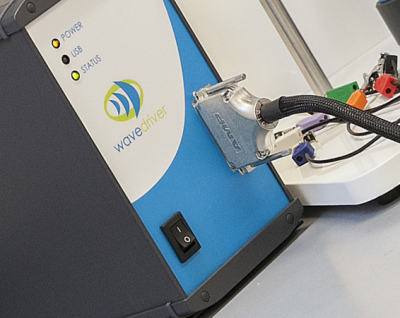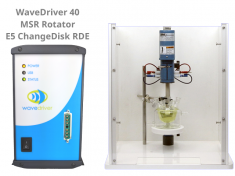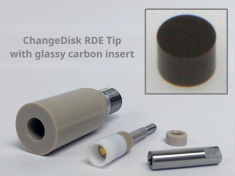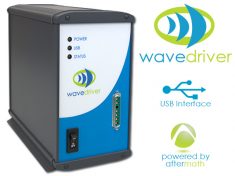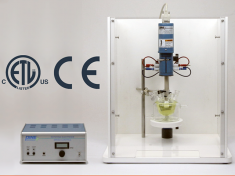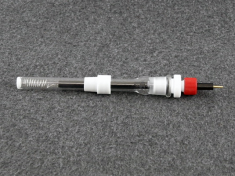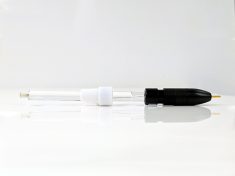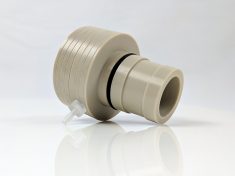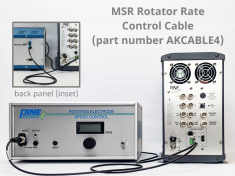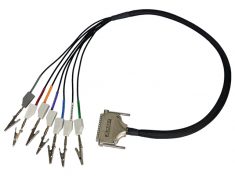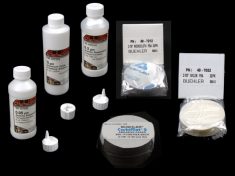| # | Description | Price in USD | |
|---|---|---|---|
| Bipotentiostat/Rotator Bundle | |||
| [WD40-MSR-RDE-E5TQ] |
MSR ChangeDisk Rotating Disk Electrode with WaveDriver 40 Bundle includes WaveDriver 40 bipotentiostat, MSR Rotator, software, cables, electrodes, cell, and accessories |
||
| Power Cords |
this bundle includes two power cords |
||
| List of All Items Included in Bundle | |||
| Software | |||
| AFP4 |
WaveDriver 40 DC Bipotentiostat/Galvanostat |
||
| AFMSRCE |
Pine Research MSR Rotator the most popular electrode rotator in the world |
||
| ACP3E01 |
WaveDriver Bipotentiostat Cell Cable |
||
| AKCABLE4 |
Rotation Rate Control Cable |
||
| AFE5TQ050PK |
ChangeDisk RDE Tip maximum rotation rate is 2500 RPM - never exceed maximum rotation rate when working with rotating electrodes. |
||
| AFED050P040GC |
Glassy Carbon Disk Insert |
||
| AFE6K050 |
Disk Ejection and Polishing Tools tools for installing, removing, and polishing disk inserts |
||
| AFE6MB |
RDE/RRDE Shaft for MSR Rotators |
||
| AFCTR5 |
Standard Platinum Counter Electrode Kit |
||
| RREF0021 |
Single-Junction Silver Chloride (Ag/AgCl) Reference Electrode |
||
| AKCELL3 |
Jacketed Glass Cell for Rotating Electrodes |
||
| AC01TPA6M |
Gas-Purged Bearing Assembly |
||
| AKPOLISH |
Polishing Solutions and Materials Kit |
||
The best way to work with a Pine Research Rotating Disk Electrode (RDE) system is to pair it with a Pine Research electrochemical workstation. This bundle gets you started with a ChangeDisk RDE tip, an interchangeable glassy carbon disk insert, a WaveDriver® series bipotentiostat/galvanostat, and a Pine Research Modulated Speed Rotator (MSR), the most popular electrode rotator in the world. Under the control of our powerful AfterMath® software package, the WaveDriver 40 DC bipotentiostat/galvanostat is capable of performing a wide range of DC electroanalytical techniques, including several Rotating Disk Electrode (RDE) methods.
The versatile Pine Research MSR Rotator lets you get started immediately with RDE experiments. Later, when you are ready to expand your research to include dual working electrode techniques, simply thread an RRDE tip on to the rotator and connect the ring electrode to the second working electrode connection on the bipotentiostat. This RDE start-up bundle includes the following principal items along with compatible cables and accessories:
- WaveDriver 40 DC Bipotentiostat/Galvanostat
- Pine Research MSR Rotator, ChangeDisk RDE tip, and glassy carbon disk insert/li>
- Pine Research AfterMath Software
- Jacketed RDE Cell (glass) with Pt Counter and Ag/AgCl Reference Electrode
See the "Description" tab below for additional information.
The WaveDriver 40 DC Bipotentiostat/Galvanostat is an affordable benchtop bipotentiostat/galvanostat system capable of performing a wide variety of single and dual working electrode DC electroanalytical techniques. Unlike many other bipotentiostat offerings on the market, the fundamental design of the WaveDriver 40 makes it just as easy for you to use two working electrodes in an electrochemical cell as it is to use just one working electrode.
True Integrated Bipotentiostat. From the software to the cell cable design, everything about the WaveDriver 40 bipotentiostat makes working with dual working electrode configurations as straightforward as possible: no messy inter-channel connections are required, and no additional cell cables or adapters are required. The WaveDriver 40 connects to your laptop or PC via a standard USB cable and is controlled by our powerful AfterMath software. The software user interface is designed with two working electrodes in mind, so entering experimental parameters for dual-electrode techniques is quick-and-easy.
If you also need to perform Electrochemical Impedance Spectroscopy (EIS), please choose one of our WaveDriver 200 bundles instead.
Applications. The WaveDriver 40 finds use in academic and industrial research laboratories around the world and across a wide variety of applications. The instrument offers a large range of accessible current ranges (±100 nA up to ±1 A) and potential ranges (±2.5V up to ±15 V) along with advanced filtering and iR compensation. Back panel connections allow rotation rate control when performing voltammetry using a Rotating Disk Electrode (RDE), Rotating Ring-Disk Electrode (RRDE), or Rotating Cylinder Electrode (RCE). Additional input/output and timing connections permit the WaveDriver to control third-party instrumentation in applications such as UV/Visible Spectroelectrochemistry.
Cost Effective. Take a look around at similar bipotentiostat/galvanostat systems and you will have a difficult time finding one with comparable specifications and capabilities at the same modest price point. Designed with the everyday user in mind, the specifications for the WaveDriver 40 bipotentiostat are broad enough to permit you to perform a wide range of routine electrochemical techniques but also prudently chosen to allow for a simple and affordable design. Popular and common techniques such as cyclic voltammetry, bulk electrolysis, differential pulse voltammetry, square wave and pulse voltammetry, battery charge/discharge sequences, corrosion techniques (such as linear polarization resistance), chronoamperometry, and chronopotentiometry are easily configured and executed using our AfterMath software package.
What makes the WaveDriver 40 bipotentiostat even more powerful?
Combining it with a precision electrode rotator manufactured by Pine Research…
MAXIMUM ROTATION RATE: Each electrode tip model used with the Pine Research MSR Rotator has a maximum rotation rate. Do not the exceed maximum rotation rate when working with rotating electrodes.
The Pine Research MSR Rotator is the most popular rotating electrode configuration worldwide. This flexible electrochemical instrument may be used with Rotating Disk Electrodes (RDE), Rotating Ring-Disk Electrodes (RRDE), and Rotating Cylinder Electrodes (RCE). The MSR Rotator bears both the CE and ETL marks and is compatible with most international power configuration standards.
The rotation rate of the electrode may be adjusted using a control knob on the front panel of the motor control unit, or alternately, the rotation rate can be controlled via an analog control signal provided by a potentiostat or by a third-party waveform generator. The rotation rate may be viewed using the LCD display on the front panel. The rotation rate is adjustable over a range from 50 to 10,000 RPM and is accurate to within 1% of the reading on the display. A rotation rate may also be monitored via an output signal proportional to the rotation rate which is available on the front panel.
The rotation rate may be controlled and modulated by a sine wave, square wave, or other externally generated waveform. The outstanding acceleration characteristics of the motor and its control circuitry allow the rotation rate to follow the control waveform with very little error. This feature is particularly desirable for techniques such as Hydrodynamic Modulation Voltammetry (HMV) .
The rotator motor position is easily raised or lowered with respect to the cell platform, making immersion or removal of the rotating electrode tip quick and easy. The enclosure base is made from chemically resistant polypropylene, and the large enclosure window provides a good view of rotating electrode during operation. (A smaller base is available separately for using the rotator in a glove box or fume hood.)
Electrode connections are made to the rotating shaft using silver-carbon brushes. There are two pairs of contacts – the red pair is for the disk, and the blue pair is for the ring.
Visit our YouTube channel for helpful instructional videos regarding the use and maintenance of this and many other Pine Research products.
All specifications are subject to change without notice.
| WaveDriver 40 DC Bipotentiostat / Galvanostat | |
|
Working Electrode Channels |
2 |
|
Measured Current Ranges |
±1 A, ±100 mA, ±10 mA, ±1 mA, ±100 μA, ±10 μA, ±1 μA, ±100 nA |
|
Autoranging |
Yes |
|
Practical Current Range |
20 pA to 1.0 A |
|
ADC Input |
16 bits |
|
Compliance Voltage |
> ±17 V |
|
Measured Potential Ranges |
±15.0 V, ±10.0 V, ±2.5 V |
|
CV Sweep Rate (min) |
10 μV/s (469 μV per 46.9 s, 313 μV step per 31.3 s or 78 μV per 7.8 s) |
|
CV Sweep Rate (max) |
75 V/s |
|
Point Interval |
80 μs (minimum) |
|
EIS Capable |
No |
|
EIS Frequency Range |
N/A |
|
Instrument Dimensions |
160 × 324 × 255 mm |
|
Instrument Weight |
4.6 kg (10.2 lb) |
|
Interface |
USB |
|
Wireless Capable |
No |
Additional Specifications |
|
| Modulated Speed Rotator (MSR) | |
|
Rate Accuracy |
100 to 200 RPM: Accurate to within ±2 counts of display reading |
|
Rate Control (external) |
Optional rate control via input signal on control unit front panel |
|
Rate Output |
Allows optional external monitoring of rotation rate (banana jack, control unit front panel) |
|
Maximum Continuous Torque |
28.3 mN m |
|
Motor Power |
15 W |
|
Electrode Connections |
Disk electrode: red banana jack on motor unit |
|
Dimensions |
Control unit: 11.4 × 10.1 × 5.75 in (29 × 26 × 15 cm) |
|
Shipping Information |
Shipping weight: 60 lb (27 kg) |
|
Rotating Disk (RDE) |
E2, E3, E4TQ, E5, E5TQ |
|
Rotating Ring-Disk (RRDE) |
E6, E7, E8 |
|
Rotating Cylinder (RCE) |
ACQC, E9 |
Additional Specifications |
|
| Single Junction Silver Chloride Reference Electrode | |
|
Standard Potential |
0.199 V vs. NHE |
|
Filling Solution |
4 M KCl with AgCl |
| Document # | Title |
|---|---|
| WaveDriver 40 DC Bipotentiostat/Galvanostat | |
|
DRU10165 |
WaveDriver 40 User Guide |
| Pine Research MSR Rotator | |
|
DRU10002 |
Pine Research MSR Rotator User Guide |
|
DRB10087 |
Pine Research MSR Electrode Rotator Marketing Brochure |
| Electrode Information | |
|
DRP10143 |
E5TQPK Series ChangeDisk Rotating Disk Electrode Information |
|
DRP10061 |
Care and Use of the Platinum Counter Electrode Kit |
|
DRP10025 |
Silver/Silver-Chloride Reference Electrode User Guide |
|
DRK10135 |
Electrode Shrouds Overview |
|
DRK10013 |
Pine Research Electrode Polishing Guide |
Contact us with any questions or support requests by phone or e-mail.
Below are selected product references:



